Non-Invasive Biometrics and Machine Learning Modeling to Obtain Sensory and Emotional Responses from Panelists during Entomophagy
Abstract
1. Introduction
2. Materials and Methods
2.1. Sensory Session Description and Video Analysis
2.2. Statistical Analysis and Machine Learning Modeling
3. Results
3.1. Results from the ANOVA of Self-Reported and Biometric Responses
 when assessing the avocado toast with crickets and the whole crickets, with more negative results for the Asians, which means that they moved the head to the right side when evaluating these samples. For joy, there were significant differences between cultures, with the avocado toast control sample having higher expression of this emotion in Asians. The Asians also behaved significantly differently to the non-Asians in terms of engagement when assessing the tortilla chips made with cricket flour, with the Asians being more engaged with the sample. The Asians expressed significantly more smiley faces
when assessing the avocado toast with crickets and the whole crickets, with more negative results for the Asians, which means that they moved the head to the right side when evaluating these samples. For joy, there were significant differences between cultures, with the avocado toast control sample having higher expression of this emotion in Asians. The Asians also behaved significantly differently to the non-Asians in terms of engagement when assessing the tortilla chips made with cricket flour, with the Asians being more engaged with the sample. The Asians expressed significantly more smiley faces  when evaluating both the avocado toast control and the toast with crickets than the non-Asians. Likewise, the Asians expressed significantly more stuck out tongue with winking eye
when evaluating both the avocado toast control and the toast with crickets than the non-Asians. Likewise, the Asians expressed significantly more stuck out tongue with winking eye  expressions when assessing the tortilla chips made with cricket flour.
expressions when assessing the tortilla chips made with cricket flour.3.2. Multivariate Data Analysis
3.2.1. Principal Components Analysis
 (FL = −0.26), disgust (FL = −0.24), and sadness (FL = −0.24) on the negative side. On the other side, PC2 was mainly represented by kissing
(FL = −0.26), disgust (FL = −0.24), and sadness (FL = −0.24) on the negative side. On the other side, PC2 was mainly represented by kissing  (FL = 0.32), rage
(FL = 0.32), rage  (FL = 0.30), and anger (FL = 0.30) on the positive side, and pitch
(FL = 0.30), and anger (FL = 0.30) on the positive side, and pitch  (FL = −0.19) on the negative side of the axis. It can be observed that both control samples (avocado toast and tortilla chip) were associated with a higher liking of flavor, purchase intention, overall liking, valence, smiley face
(FL = −0.19) on the negative side of the axis. It can be observed that both control samples (avocado toast and tortilla chip) were associated with a higher liking of flavor, purchase intention, overall liking, valence, smiley face , and roll
, and roll  , while the tortilla chip made with cricket flour was associated with emotions and emojis such as anger, rage
, while the tortilla chip made with cricket flour was associated with emotions and emojis such as anger, rage , smirk
, smirk  , and laughing
, and laughing  . On the other hand, the avocado toast with crickets was associated with winking face
. On the other hand, the avocado toast with crickets was associated with winking face  , disgust, sadness, and flushed face
, disgust, sadness, and flushed face  , while the whole crickets were associated with disgust and pitch
, while the whole crickets were associated with disgust and pitch .
. (FL = 0.25), engagement (FL = 0.24), and relaxed
(FL = 0.25), engagement (FL = 0.24), and relaxed  (FL = 0.24), and on the negative side by the self-reported responses (FL = 0.24) appearance, texture, flavor, overall liking, and purchase intention. The PC2 was mainly represented by pitch
(FL = 0.24), and on the negative side by the self-reported responses (FL = 0.24) appearance, texture, flavor, overall liking, and purchase intention. The PC2 was mainly represented by pitch  (FL = 0.38) and stuck out tongue with winking eye
(FL = 0.38) and stuck out tongue with winking eye  (FL = 0.21) on the positive side of the axis, and by surprise (FL = −0.34), laughing
(FL = 0.21) on the positive side of the axis, and by surprise (FL = −0.34), laughing  (FL = −0.34), and disappointed
(FL = −0.34), and disappointed  (FL = −0.34) on the negative side. The control sample of the tortilla chip was associated with yaw
(FL = −0.34) on the negative side. The control sample of the tortilla chip was associated with yaw  , and disappointed
, and disappointed  , while the control sample of avocado toast and tortilla chip with cricket flour were mainly linked with the liking of aroma and flavor, as well as disgust. On the other hand, the avocado toast with crickets was associated with pitch
, while the control sample of avocado toast and tortilla chip with cricket flour were mainly linked with the liking of aroma and flavor, as well as disgust. On the other hand, the avocado toast with crickets was associated with pitch  , stuck out tongue with winking eye
, stuck out tongue with winking eye  , disgust, and smirk
, disgust, and smirk  , while the whole crickets were linked with joy, valence, relaxed
, while the whole crickets were linked with joy, valence, relaxed  , anger, rage
, anger, rage  , engagement, and attention.
, engagement, and attention.3.2.2. Correlation Analysis
 (r = −0.94), and disgust (r = −0.95), while the liking of flavor had a negative correlation with winking face
(r = −0.94), and disgust (r = −0.95), while the liking of flavor had a negative correlation with winking face  (r = 0.93), and the latter with FS Taste (r = −0.88). On the other hand, Figure 3b shows the significant correlations (p ≤ 0.05) found for non-Asians. It can be observed that joy had a negative correlation with the liking of appearance (r = −0.94), FS App (r = −0.95), the liking of texture (r = −0.97), flavor (r = −0.89), overall liking (r = −0.94), FS Taste (r = −0.89), and purchase intention (r = −0.96). Valence had a negative correlation with appearance liking (r = −0.97), FS App (r = −0.97), texture liking (r = −0.96), overall liking (r = −0.95), and FS Taste (r = −0.96). Similarly, relaxed
(r = 0.93), and the latter with FS Taste (r = −0.88). On the other hand, Figure 3b shows the significant correlations (p ≤ 0.05) found for non-Asians. It can be observed that joy had a negative correlation with the liking of appearance (r = −0.94), FS App (r = −0.95), the liking of texture (r = −0.97), flavor (r = −0.89), overall liking (r = −0.94), FS Taste (r = −0.89), and purchase intention (r = −0.96). Valence had a negative correlation with appearance liking (r = −0.97), FS App (r = −0.97), texture liking (r = −0.96), overall liking (r = −0.95), and FS Taste (r = −0.96). Similarly, relaxed  was negatively correlated with appearance liking (r = −0.92), FS App (r = −0.94), texture liking (r = −0.96), overall liking (r = −0.90), and purchase intention (r = −0.93). Smiley has a negative correlation with appearance liking (r = −0.89), FS App (r = −0.88), liking of aroma (r = −0.89), texture (r = −0.91), flavor (r = 0.92), overall liking (r = −0.90), and purchase intention (r = −0.90).
was negatively correlated with appearance liking (r = −0.92), FS App (r = −0.94), texture liking (r = −0.96), overall liking (r = −0.90), and purchase intention (r = −0.93). Smiley has a negative correlation with appearance liking (r = −0.89), FS App (r = −0.88), liking of aroma (r = −0.89), texture (r = −0.91), flavor (r = 0.92), overall liking (r = −0.90), and purchase intention (r = −0.90).3.2.3. Multiple Factor Analysis
 (FL = 0.93), and laughing
(FL = 0.93), and laughing  (FL = 0.91) on the positive side of the axis, and by savoring
(FL = 0.91) on the positive side of the axis, and by savoring  (FL = −1.00) and appearance liking (FL = −0.99) on the negative side. On the other hand, F2 was mainly represented on the positive side of the axis by rage
(FL = −1.00) and appearance liking (FL = −0.99) on the negative side. On the other hand, F2 was mainly represented on the positive side of the axis by rage  (FL = 0.97) and kissing
(FL = 0.97) and kissing  (FL = 0.93), and on the negative side by unamused
(FL = 0.93), and on the negative side by unamused  (FL = −0.49) and pitch
(FL = −0.49) and pitch  (FL = −0.42). It can be observed that the control samples (tortilla chip and avocado toast) were associated mainly with self-reported responses such as the liking of flavor, aroma, overall liking, and purchase intention, as well as some subconscious responses such as roll
(FL = −0.42). It can be observed that the control samples (tortilla chip and avocado toast) were associated mainly with self-reported responses such as the liking of flavor, aroma, overall liking, and purchase intention, as well as some subconscious responses such as roll  , smiley
, smiley  , and valence. The tortilla chip made with cricket flour was associated with emojis measured with biometrics such as kissing
, and valence. The tortilla chip made with cricket flour was associated with emojis measured with biometrics such as kissing  , laughing
, laughing  , rage
, rage  , and stuck out tongue with winking eye
, and stuck out tongue with winking eye  , and with neutral
, and with neutral  from the CATA test. On the other hand, the avocado toast with crickets was associated with emojis from the CATA test, such as disappointed
from the CATA test. On the other hand, the avocado toast with crickets was associated with emojis from the CATA test, such as disappointed  , confused
, confused  , and winking face
, and winking face  from the biometrics. The whole crickets were linked to emojis from the CATA test, such as laughing
from the biometrics. The whole crickets were linked to emojis from the CATA test, such as laughing  , surprised
, surprised  , expressionless
, expressionless  , and pitch
, and pitch  .
. (FL = 0.99), disappointed
(FL = 0.99), disappointed  (FL = 0.99), and confused
(FL = 0.99), and confused  (FL = 0.99) on the positive side of the axis, and by texture liking (FL = −1.00), happy
(FL = 0.99) on the positive side of the axis, and by texture liking (FL = −1.00), happy  (FL = −0.99), liking of appearance (FL = −0.99), FS App (FL = −0.99), and purchase intention (FL = −0.99) on the negative side. On the other hand, F2 was represented by pitch
(FL = −0.99), liking of appearance (FL = −0.99), FS App (FL = −0.99), and purchase intention (FL = −0.99) on the negative side. On the other hand, F2 was represented by pitch  (FL = 0.97) on the positive side of the axis, and by laughing
(FL = 0.97) on the positive side of the axis, and by laughing  (FL = −0.95) and scared
(FL = −0.95) and scared  (FL = −0.84) on the negative side. The control sample of the tortilla chip was mainly associated with head movements such as yaw
(FL = −0.84) on the negative side. The control sample of the tortilla chip was mainly associated with head movements such as yaw  and roll
and roll  and disappointed
and disappointed  . The control sample of the avocado toast and the tortilla chip made with cricket flour were associated with self-reported responses such as the liking of aroma, flavor, overall liking, and purchase intention as well as flushed
. The control sample of the avocado toast and the tortilla chip made with cricket flour were associated with self-reported responses such as the liking of aroma, flavor, overall liking, and purchase intention as well as flushed  . The avocado toast with crickets was mainly associated with emojis from the CATA test, such as laughing
. The avocado toast with crickets was mainly associated with emojis from the CATA test, such as laughing  , disappointed
, disappointed  , unamused
, unamused  , confused
, confused  , and neutral
, and neutral  , and with biometric responses such as valence, stuck out tongue
, and with biometric responses such as valence, stuck out tongue  , and smirk
, and smirk  . On the other hand, the whole crickets were linked to the biometric responses such as engagement, rage
. On the other hand, the whole crickets were linked to the biometric responses such as engagement, rage  , winking face
, winking face  , and relaxed
, and relaxed  , and with emojis from the CATA test such as surprised
, and with emojis from the CATA test such as surprised  and expressionless
and expressionless  .
.3.3. Machine Learning Modeling
4. Discussion
5. Conclusions
Supplementary Materials
Author Contributions
Funding
Conflicts of Interest
References
- House, J. Consumer acceptance of insect-based foods in the Netherlands: Academic and commercial implications. Appetite 2016, 107, 47–58. [Google Scholar] [CrossRef] [PubMed]
- La Barbera, F.; Verneau, F.; Amato, M.; Grunert, K. Understanding Westerners’ disgust for the eating of insects: The role of food neophobia and implicit associations. Food Qual. Prefer. 2018, 64, 120–125. [Google Scholar] [CrossRef]
- Hartmann, C.; Siegrist, M. Insects as food: Perception and acceptance. Findings from current research. Ernahr. Umsch. 2017, 64, 44–50. [Google Scholar]
- Lensvelt, E.J.; Steenbekkers, L. Exploring consumer acceptance of entomophagy: A survey and experiment in Australia and the Netherlands. Ecol. Food. Nutr. 2014, 53, 543–561. [Google Scholar] [CrossRef]
- Wilkinson, K.; Muhlhausler, B.; Motley, C.; Crump, A.; Bray, H.; Ankeny, R. Australian consumers’ awareness and acceptance of insects as food. Insects 2018, 9, 44. [Google Scholar] [CrossRef]
- van Huis, A.; Itterbeeck, J.V.; Klunder, H.; Mertens, E.; Halloran, A.; Muir, G.; Vantomme, P. Edible Insects: Future Prospects for Food and Feed Security; FAO: Rome, Italy, 2013. [Google Scholar]
- Rumpold, B.A.; Schlüter, O. Insect-based protein sources and their potential for human consumption: Nutritional composition and processing. Anim. Front. 2015, 5, 20–24. [Google Scholar]
- Rumpold, B.A.; Schlüter, O.K. Nutritional composition and safety aspects of edible insects. Mol. Nutr. Food Res. 2013, 57, 802–823. [Google Scholar] [CrossRef]
- Oonincx, D.G.; van Itterbeeck, J.; Heetkamp, M.J.; van den Brand, H.; van Loon, J.J.; van Huis, A. An exploration on greenhouse gas and ammonia production by insect species suitable for animal or human consumption. PLoS ONE 2010, 5, e14445. [Google Scholar] [CrossRef]
- Kouřimská, L.; Adámková, A. Nutritional and sensory quality of edible insects. NFS J. 2016, 4, 22–26. [Google Scholar] [CrossRef]
- Van Huis, A. Did early humans consume insects? J. Insects Food Feed 2017, 3, 161–163. [Google Scholar] [CrossRef]
- Verbeke, W. Profiling consumers who are ready to adopt insects as a meat substitute in a Western society. Food Qual. Prefer. 2015, 39, 147–155. [Google Scholar] [CrossRef]
- Sogari, G. Entomophagy and Italian consumers: An exploratory analysis. Prog. Nutr. 2015, 17, 311–316. [Google Scholar]
- Gmuer, A.; Guth, J.N.; Hartmann, C.; Siegrist, M. Effects of the degree of processing of insect ingredients in snacks on expected emotional experiences and willingness to eat. Food Qual. Prefer. 2016, 54, 117–127. [Google Scholar] [CrossRef]
- Viejo, G.C.; Fuentes, S.; Howell, K.; Torrico, D.; Dunshea, F. Robotics and computer vision techniques combined with non-invasive consumer biometrics to assess quality traits from beer foamability using machine learning: A potential for artificial intelligence applications. Food Control. 2018, 92, 72–79. [Google Scholar] [CrossRef]
- Viejo, G.C.; Fuentes, S.; Howell, K.; Torrico, D.; Dunshea, F. Integration of non-invasive biometrics with sensory analysis techniques to assess acceptability of beer by consumers. Physiol. Behav. 2019, 200, 139–147. [Google Scholar] [CrossRef]
- Gunaratne, N.M.; Fuentes, S.; Gunaratne, T.M.; Torrico, D.D.; Francis, C.; Ashman, H.; Viejo, C.G.; Dunshea, F.R. Effects of packaging design on sensory liking and willingness to purchase: A study using novel chocolate packaging. Heliyon 2019, 5, e01696. [Google Scholar] [CrossRef]
- Megido, R.C.; Gierts, C.; Blecker, C.; Brostaux, Y.; Haubruge, É.; Alabi, T.; Francis, F. Consumer acceptance of insect-based alternative meat products in Western countries. Food Qual. Prefer. 2016, 52, 237–243. [Google Scholar] [CrossRef]
- Smith, T.W. The Book of Human Emotions: An Encyclopedia of Feeling from Anger to Wanderlust; Profile Books: London, UK, 2015. [Google Scholar]
- Torrico, D.D.; Fuentes, S.; Gonzalez Viejo, C.; Ashman, H.; Gunaratne, N.M.; Gunaratne, T.M.; Dunshea, F.R. Images and chocolate stimuli affect physiological and affective responses of consumers: A cross-cultural study. Food Qual. Prefer. 2018, 65, 60–71. [Google Scholar] [CrossRef]
- Gunaratne, N.M.; Fuentes, S.; Gunaratne, T.M.; Torrico, D.D.; Ashman, H.; Francis, C.; Gonzalez Viejo, C.; Dunshea, F.R. Consumer acceptability, eye fixation, and physiological responses: A study of novel and familiar chocolate packaging designs using eye-tracking devices. Foods 2019, 8, 253. [Google Scholar] [CrossRef]
- Schouteten, J.J.; De Steur, H.; de Pelsmaeker, S.; Lagast, S.; Juvinal, J.G.; de Bourdeaudhuij, I.; Verbeke, W.; Gellynck, X. Emotional and sensory profiling of insect-, plant-and meat-based burgers under blind, expected and informed conditions. Food Qual. Prefer. 2016, 52, 27–31. [Google Scholar] [CrossRef]
- Castro, M.; Chambers, E. Consumer Avoidance of Insect Containing Foods: Primary Emotions, Perceptions and Sensory Characteristics Driving Consumers Considerations. Foods 2019, 8, 351. [Google Scholar] [CrossRef] [PubMed]
- Jensen, N.H.; Lieberoth, A. We will eat disgusting foods together–Evidence of the normative basis of Western entomophagy-disgust from an insect tasting. Food Qual. Prefer. 2019, 72, 109–115. [Google Scholar] [CrossRef]
- Jaeger, S.R.; Lee, S.M.; Kim, K.-O.; Chheang, S.L.; Jin, D.; Ares, G. Measurement of product emotions using emoji surveys: Case studies with tasted foods and beverages. Food Qual. Prefer. 2017, 62, 46–59. [Google Scholar] [CrossRef]
- Kaye, L.K.; Wall, H.J.; Malone, S.A. “Turn that frown upside-down”: A contextual account of emoticon usage on different virtual platforms. Computs. Hum. Behav. 2016, 60, 463–467. [Google Scholar] [CrossRef]
- Jaeger, S.R.; Vidal, L.; Kam, K.; Ares, G. Can emoji be used as a direct method to measure emotional associations to food names? Preliminary investigations with consumers in USA and China. Food Qual. Prefer. 2017, 56, 38–48. [Google Scholar] [CrossRef]
- Gunaratne, T.M.; Fuentes, S.; Gunaratne, N.M.; Torrico, D.D.; Gonzalez Viejo, C.; Dunshea, F.R. Physiological responses to basic tastes for sensory evaluation of chocolate using biometric techniques. Foods 2019, 8, 243. [Google Scholar] [CrossRef]
- Gunaratne, M. Implementation of non-invasive biometrics to identify effects of chocolate packaging towards consumer emotional and sensory responses. Ph.D. Thesis, The University of Melbourne, Melbourne, Australia, 2019. [Google Scholar]
- Fuentes, S.; Viejo, G.C.; Torrico, D.; Dunshea, F. Development of a biosensory computer application to assess physiological and emotional responses from sensory panelists. Sensors 2018, 18, 2958. [Google Scholar] [CrossRef]
- Menozzi, D.; Sogari, G.; Veneziani, M.; Simoni, E.; Mora, C. Eating novel foods: An application of the Theory of Planned Behaviour to predict the consumption of an insect-based product. Food Qual. Prefer. 2017, 59, 27–34. [Google Scholar] [CrossRef]
- Dibeklioglu, H.; Gevers, T. Automatic estimation of taste liking through facial expression dynamics. IEEE Trans. Affect. Comput. 2018. [Google Scholar] [CrossRef]
- Zhi, R.; Wan, J.; Zhang, D.; Li, W. Correlation between hedonic liking and facial expression measurement using dynamic affective response representation. Food Res. Int. 2018, 108, 237–245. [Google Scholar] [CrossRef]
- Rocha-Parra, D.; García-Burgos, D.; Munsch, S.; Chirife, J.; Zamora, M.C. Application of hedonic dynamics using multiple-sip temporal-liking and facial expression for evaluation of a new beverage. Food Qual. Prefer. 2016, 52, 153–159. [Google Scholar] [CrossRef]
- Buss, D. Food Companies Get Smart about Artificial Intelligence. Food Techinol. 2018, 72, 26–41. [Google Scholar]
- Gonzalez Viejo, C.; Fuentes, S. Beer Aroma and Quality Traits Assessment Using Artificial Intelligence. Fermentation 2020, 6, 56. [Google Scholar] [CrossRef]
- Hetherington, M.; Madrelle, J.; Nekitsing, C.; Barends, C.; de Graaf, C.; Morgan, S.; Parrott, H.; Weenen, H. Developing a novel tool to assess liking and wanting in infants at the time of complementary feeding–The Feeding Infants: Behaviour and Facial Expression Coding System (FIBFECS). Food Qual. Prefer. 2016, 48, 238–250. [Google Scholar] [CrossRef]
- Nekitsing, C.; Madrelle, J.; Barends, C.; de Graaf, C.; Parrott, H.; Morgan, S.; Weenen, H.; Hetherington, M. Application and validation of the Feeding Infants: Behaviour and Facial Expression Coding System (FIBFECS) to assess liking and wanting in infants at the time of complementary feeding. Food Qual. Prefer. 2016, 48, 228–237. [Google Scholar] [CrossRef]
- Torrico, D.D.; Fuentes, S.; Viejo, C.G.; Ashman, H.; Gurr, P.A.; Dunshea, F.R. Analysis of thermochromic label elements and colour transitions using sensory acceptability and eye tracking techniques. LWT 2018, 89, 475–481. [Google Scholar] [CrossRef]
- Viejo, G.C.; Torrico, D.; Dunshea, F.; Fuentes, S. Development of Artificial Neural Network Models to Assess Beer Acceptability Based on Sensory Properties Using a Robotic Pourer: A Comparative Model Approach to Achieve an Artificial Intelligence System. Beverages 2019, 5, 33. [Google Scholar] [CrossRef]

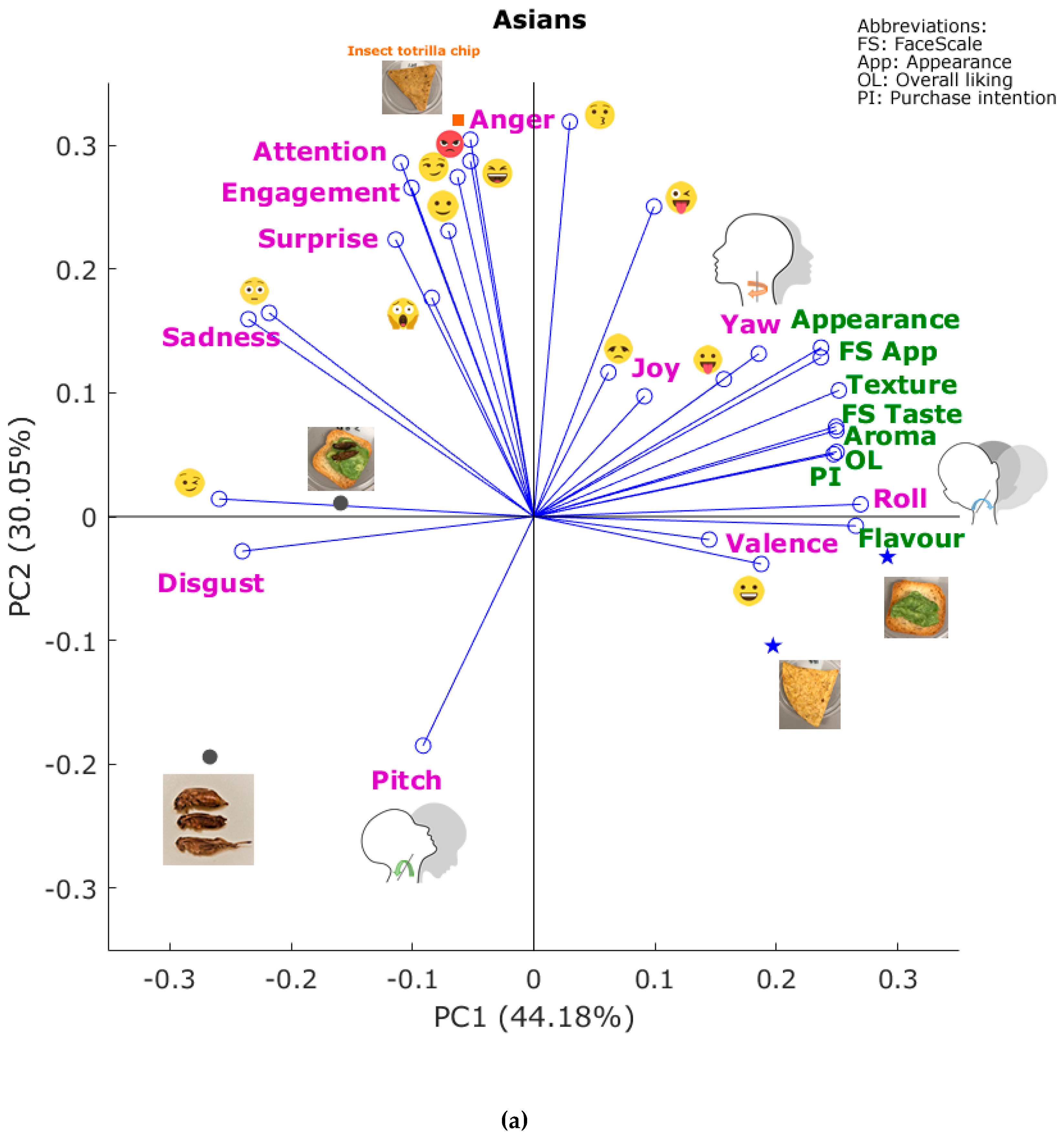
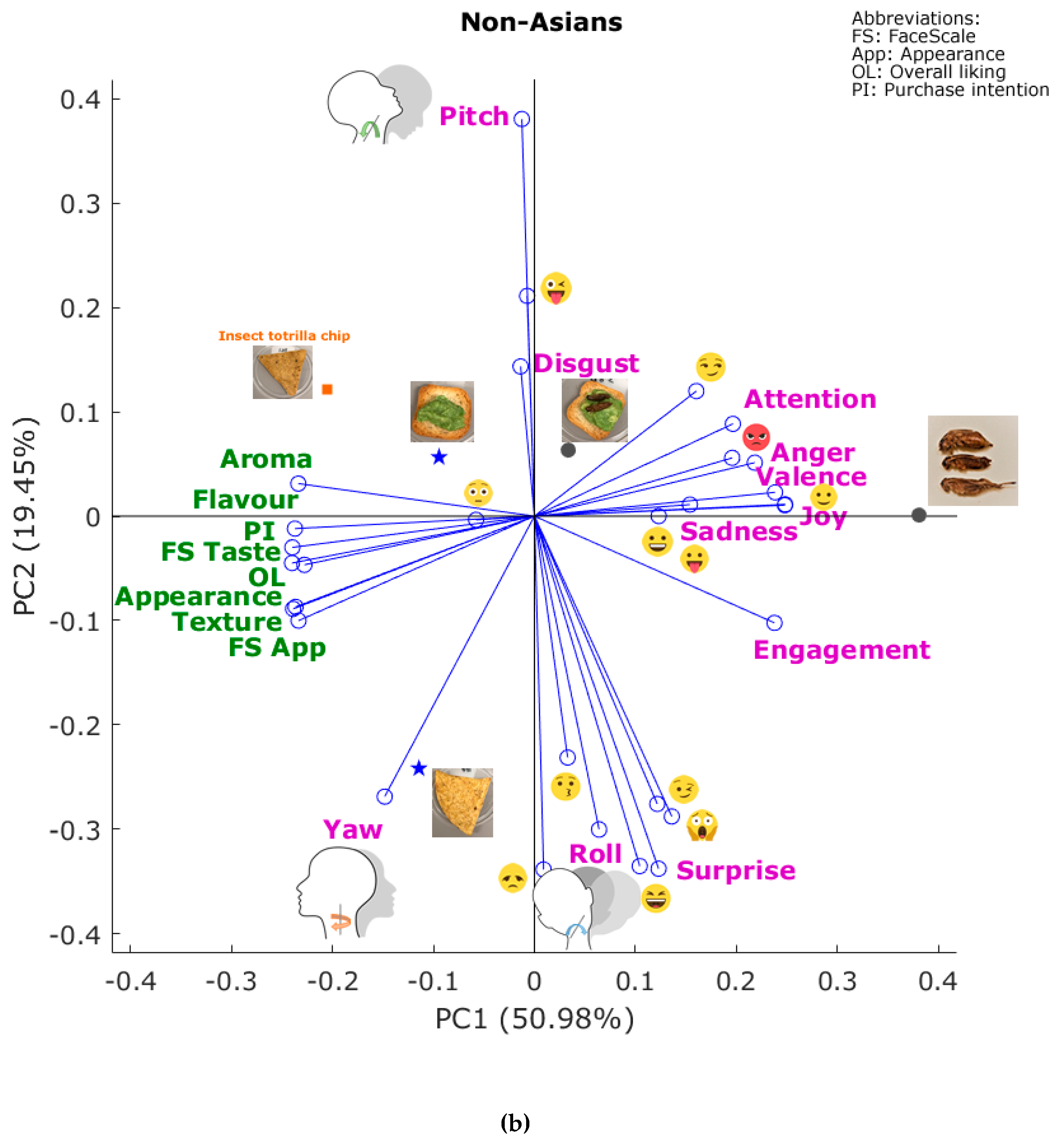
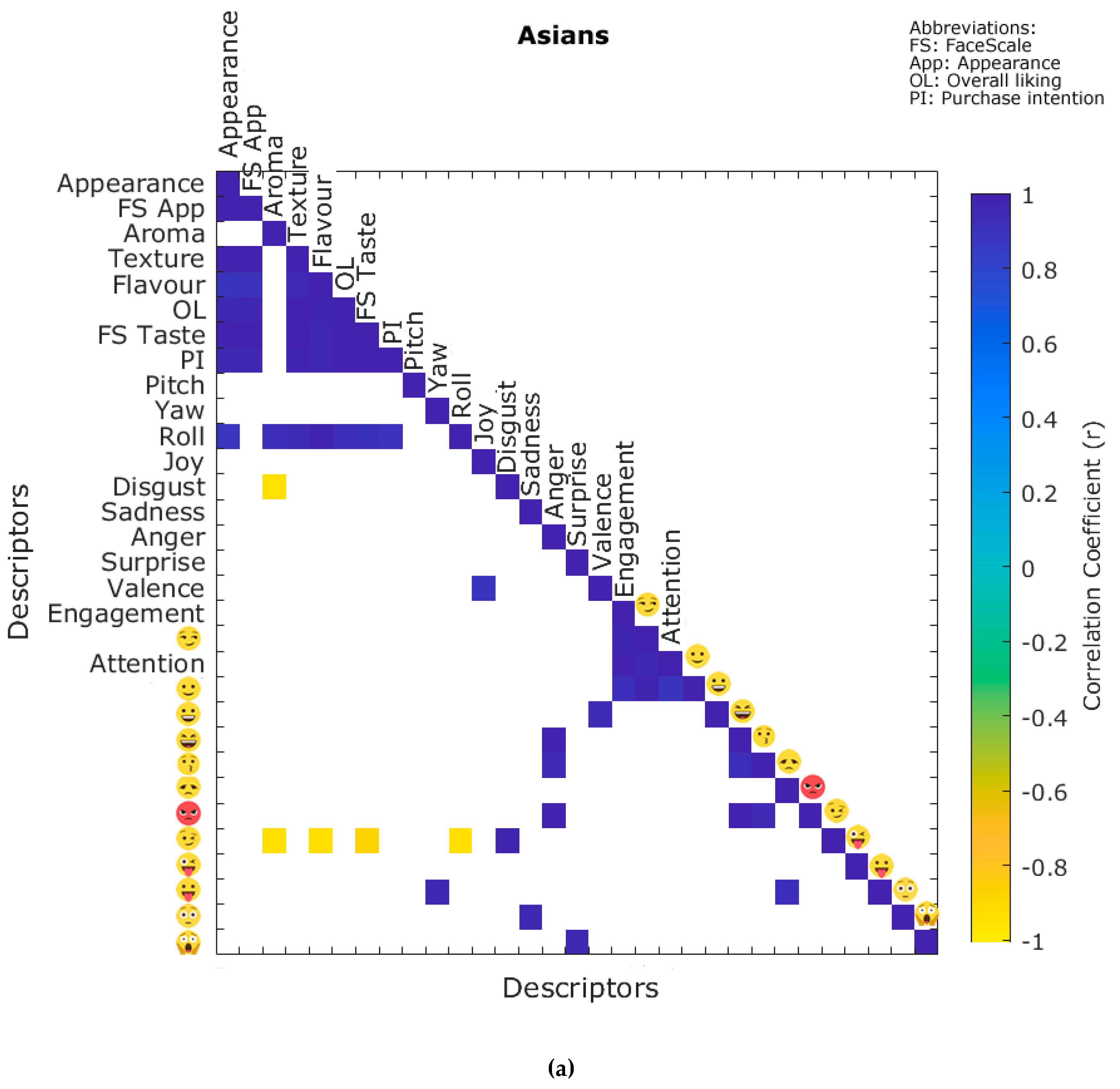
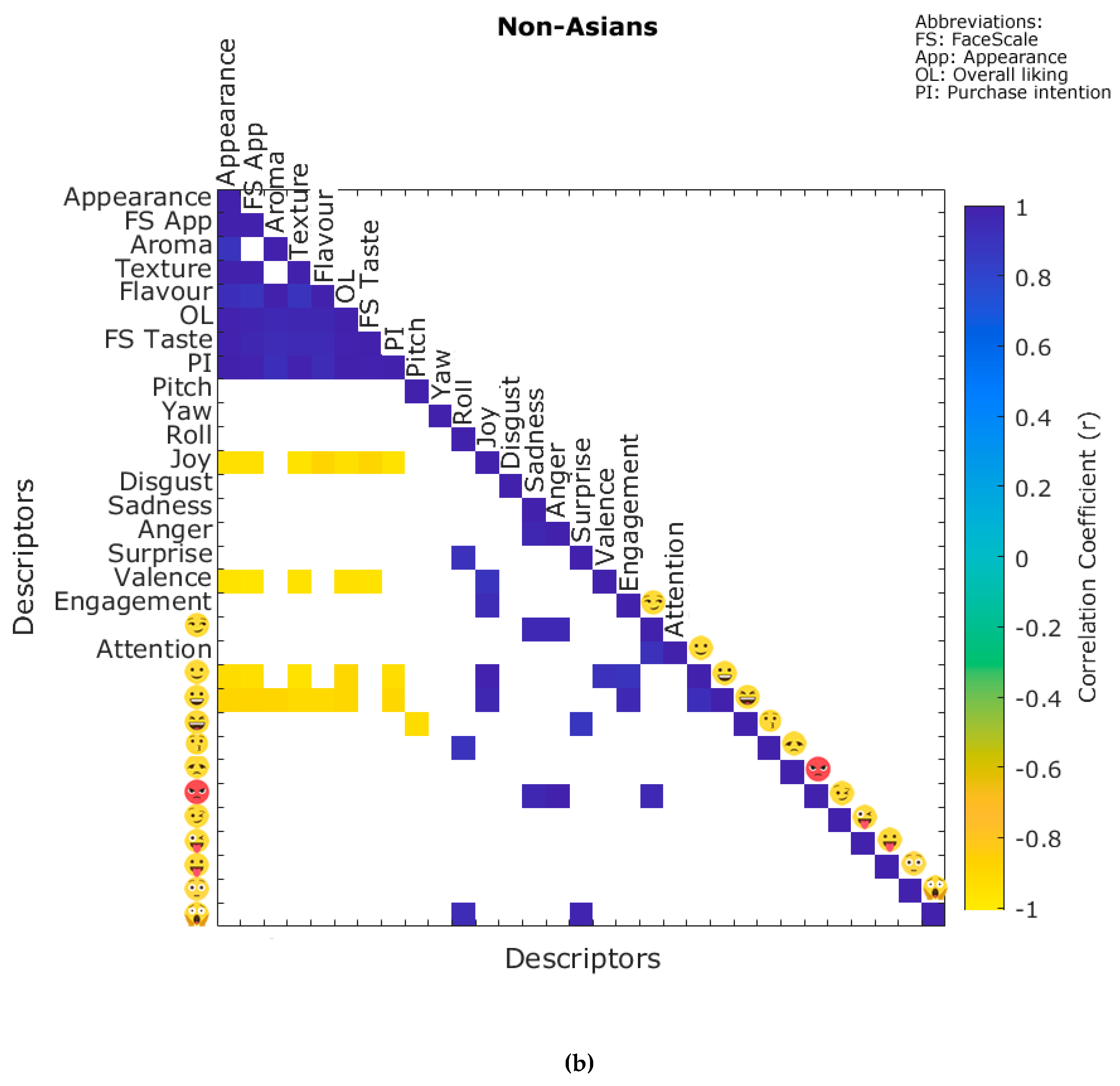
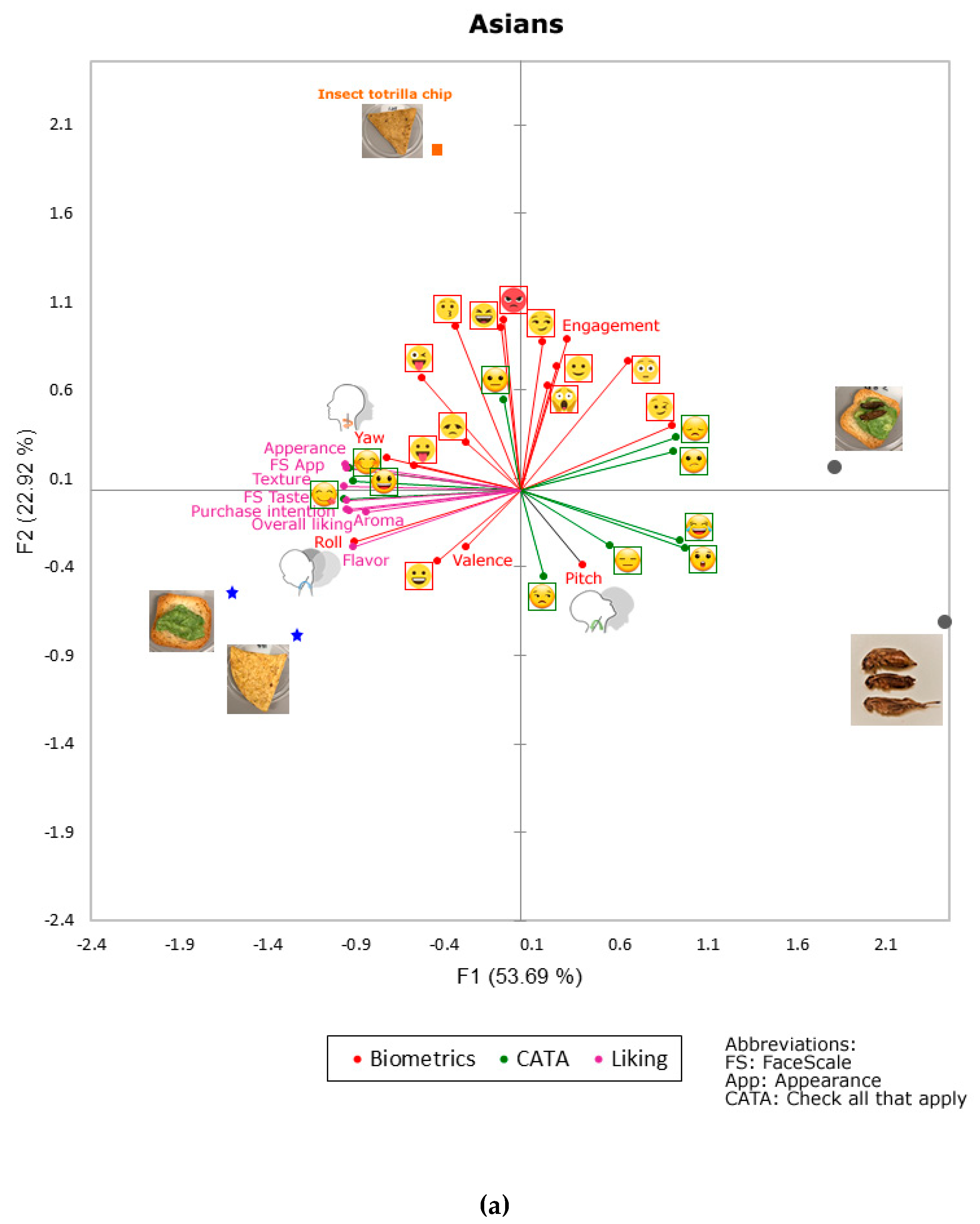
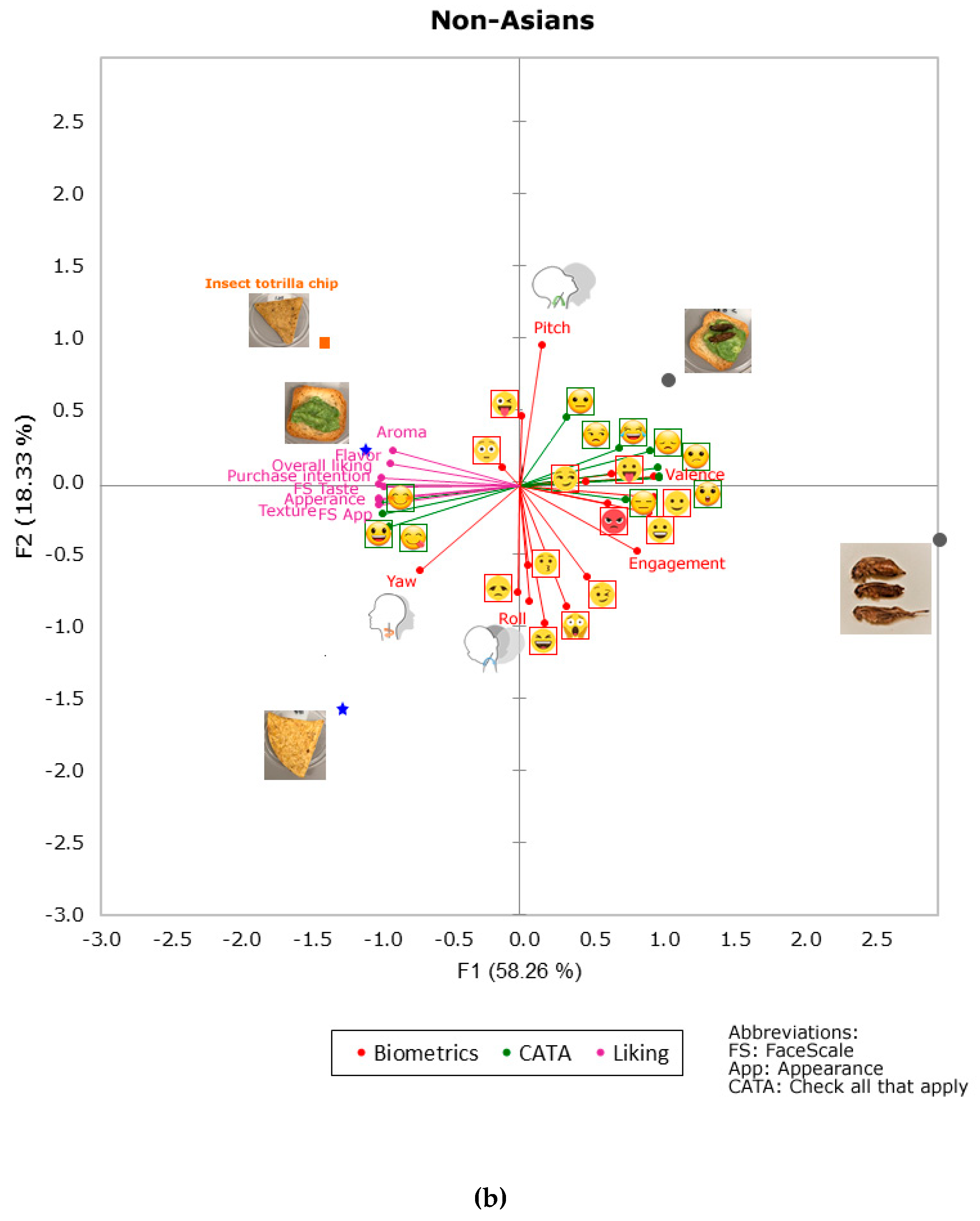
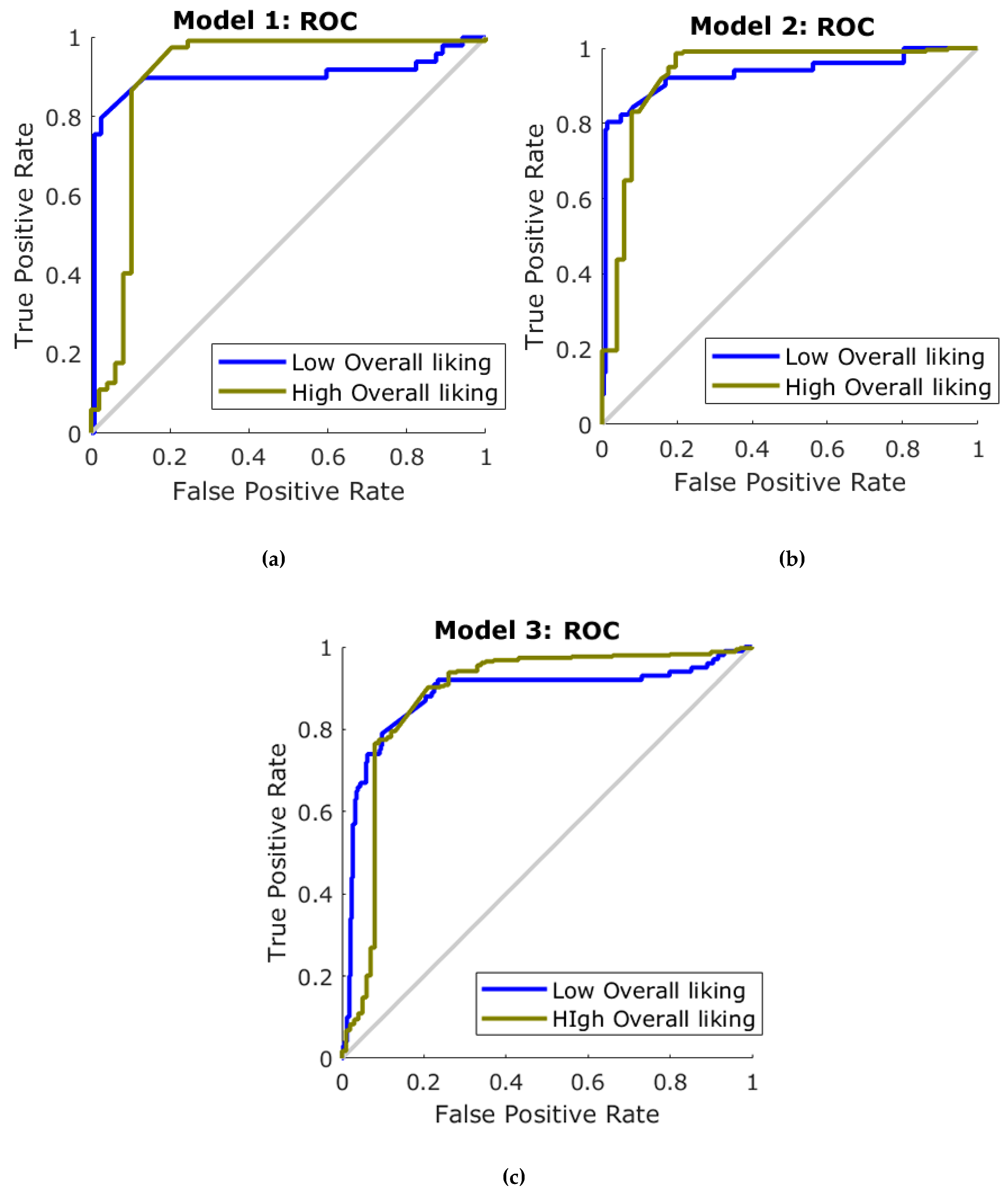
| Sample Image | Sample Description |
|---|---|
 | Tortilla chip with cornflour (Control) |
 | Toast with avocado (Control) |
 | Tortilla chip with corn and cricket flour |
 | Toast with avocado and crickets |
 | Roasted crickets |
| Descriptor | Scale | Anchors | Label |
|---|---|---|---|
| Appearance | 15 cm non-structured | Dislike extremely-Neither like nor dislike-Like extremely | Appearance |
| Appearance | FaceScale (0–100) |  | FS App |
| Aroma | 15 cm non-structured | Dislike extremely-Neither like nor dislike-Like extremely | Aroma |
| Texture | 15 cm non-structured | Dislike extremely-Neither like nor dislike-Like extremely | Texture |
| Flavor | 15 cm non-structured | Dislike extremely-Neither like nor dislike-Like extremely | Flavor |
| Overall liking | 15 cm non-structured | Dislike extremely-Neither like nor dislike-Like extremely | OL |
| Tasting | FaceScale (0–100) |  | FS Taste |
| Purchase intention | 15 cm non-structured | Dislike extremely-Neither like nor dislike-Like extremely | PI |
| Emoji | Meaning | Emoji | Meaning |
|---|---|---|---|
 | Happy |  | Savoring |
 | Surprised |  | Scared |
 | Expressionless |  | Angry |
 | Disappointed |  | Confused |
 | Neutral |  | Joy |
 | Unamused |  | Laughing |
| Parameter | Label | Parameter | Label | Parameter | Label |
|---|---|---|---|---|---|
| Joy | Joy | Winking face |  | Lip Corner Depressor | LCD |
| Disgust | Disgust | Rage |  | Lip Press | LPr |
| Sadness | Sadness | Smirk |  | Lip Suck | LS |
| Surprise | Surprise | Disappointed |  | Mouth Open | MO |
| Anger | Anger | Scared |  | Smirk Facial Expression | SmirkFE |
| Fear | Fear | Stuck out tongue with winking eye |  | Eye Closure | EC |
| Contempt | Contempt | Laughing |  | Eye Widen | EW |
| Valence | Valence | Kissing |  | Cheek Raise | CR |
| Smile | Smile | Inner Brow Raise | IBR | Lid Tighten | LT |
| Engagement | Engagement | Brow Rise | BR | Dimpler | Dimpler |
| Attention | Attention | Brow Furrow | BF | Lip Stretch | LSt |
| Smiley |  | Nose Wrinkle | NW | Jaw Drop | JD |
| Relaxed |  | Upper Lip Rise | ULR | Pitch |  |
| Stuck out tongue |  | Chin Raise | CR | Yaw |  |
| Flushed |  | Lip Pucker | LP | Roll |  |
| Stage | Samples × Participants | Accuracy | Error | Performance (MSE) |
|---|---|---|---|---|
| Model 1: Asians | ||||
| Training | 134 | 97% | 3% | 0.03 |
| Testing | 34 | 71% | 29% | 0.24 |
| Overall | 168 | 92% | 8% | - |
| Model 2: Non-Asians | ||||
| Training | 216 | 99% | 1% | 0.01 |
| Testing | 54 | 76% | 24% | 0.20 |
| Overall | 270 | 94% | 6% | - |
| Model 3: General | ||||
| Training | 350 | 97% | 3% | 0.03 |
| Testing | 88 | 71% | 29% | 0.25 |
| Overall | 438 | 89% | 11% | - |
© 2020 by the authors. Licensee MDPI, Basel, Switzerland. This article is an open access article distributed under the terms and conditions of the Creative Commons Attribution (CC BY) license (http://creativecommons.org/licenses/by/4.0/).
Share and Cite
Fuentes, S.; Wong, Y.Y.; Gonzalez Viejo, C. Non-Invasive Biometrics and Machine Learning Modeling to Obtain Sensory and Emotional Responses from Panelists during Entomophagy. Foods 2020, 9, 903. https://doi.org/10.3390/foods9070903
Fuentes S, Wong YY, Gonzalez Viejo C. Non-Invasive Biometrics and Machine Learning Modeling to Obtain Sensory and Emotional Responses from Panelists during Entomophagy. Foods. 2020; 9(7):903. https://doi.org/10.3390/foods9070903
Chicago/Turabian StyleFuentes, Sigfredo, Yin Y. Wong, and Claudia Gonzalez Viejo. 2020. "Non-Invasive Biometrics and Machine Learning Modeling to Obtain Sensory and Emotional Responses from Panelists during Entomophagy" Foods 9, no. 7: 903. https://doi.org/10.3390/foods9070903
APA StyleFuentes, S., Wong, Y. Y., & Gonzalez Viejo, C. (2020). Non-Invasive Biometrics and Machine Learning Modeling to Obtain Sensory and Emotional Responses from Panelists during Entomophagy. Foods, 9(7), 903. https://doi.org/10.3390/foods9070903







